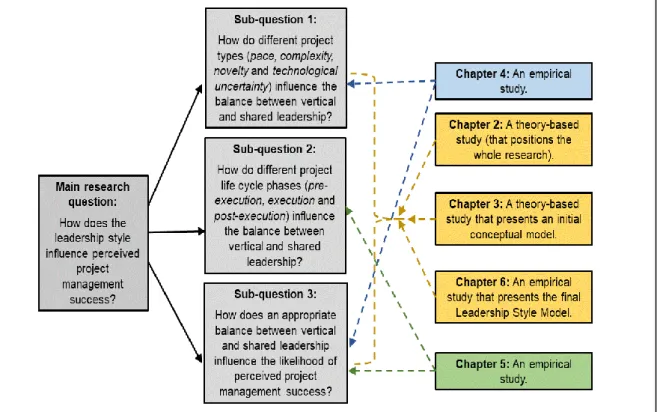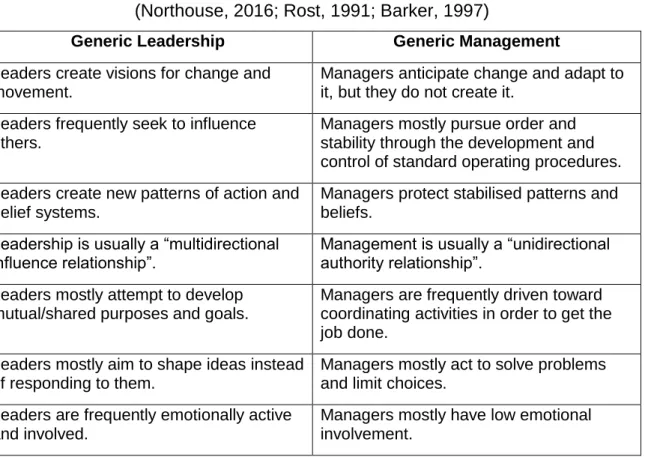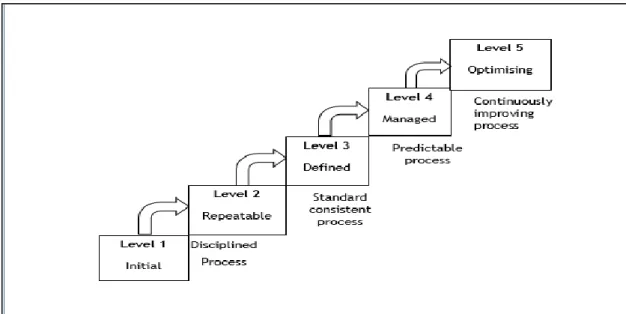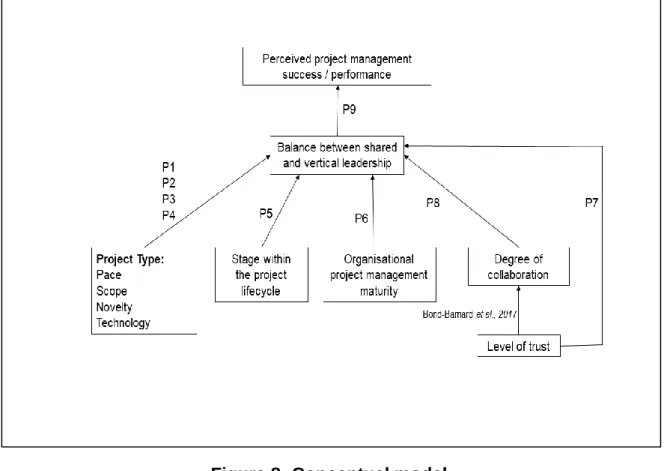It also confirms that an appropriate balance between vertical and shared leadership improves the likelihood of project management success. How the appropriate balance between vertical and shared leadership affects the likelihood of perceived project management success.
Introduction
- Setting the scene
- Leadership
- Project types
- Project life cycle phases
- Project management success
- Research goal and questions
- Research contributions
Whether an appropriate balance of management styles improves the likelihood of perceived project management success (details in Chapters 4, 5 and 6). Conceptualizing the lessons-learned process in project management: Towards a triple-loop learning framework', International Journal of Project Management, 35(7), pp.
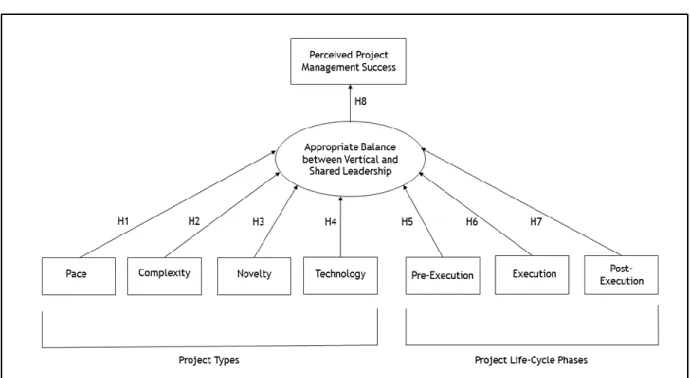
Leadership styles in projects. Current trends and future
Literature review
- Leadership theories during the past decades
- Leadership approaches, theories and styles
- Definition of leadership
- Leadership and management: Differences and similarities
- Leadership in project management
- Vertical leadership
- Shared leadership
- Horizontal leadership
- The difference between shared and horizontal leadership
- The appropriate balance between vertical and shared leadership
In contrast, shared leadership is a collaborative act and delegation of control to the most appropriate team members is necessary (Agarwal et al., 2017). Shared leadership is closely related to horizontal leadership and complementary to vertical leadership in balanced leadership (Müller et al., 2017).
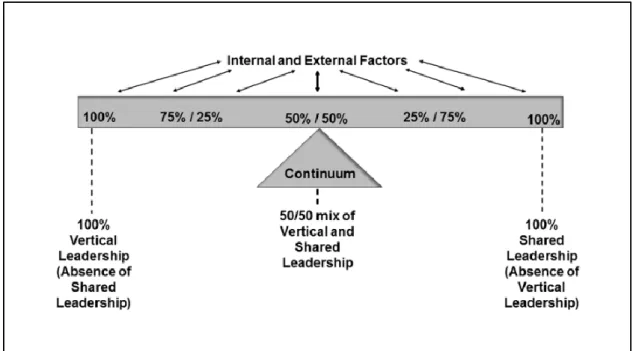
Future directions and opportunities
Projects rarely depend solely on one or the other form of leadership and in most cases a combination of vertical and shared leadership is used (Müller et al., 2016). To achieve this, it is necessary to develop a new model of shared leadership processes that has practical value for project managers (Clarke, 2012).
Conclusion and discussion
The importance of vertical and shared leadership in new venture top management teams: Implications for start-up firm performance. Shared Leadership: A State-of-the-Art Review and Future Research Agenda forthcoming in Journal of Organizational Behavior.
Exploring project-related factors that influence leadership styles
Vertical leadership
In such a hierarchy, a formally designated manager acts as the main source of instruction, supervision, and control for those who report to him or her. Employees at the higher organizational levels can help as a source of control and supervision for other team members, while the designated manager delegates specific tasks to other team members.
Shared leadership
In its extreme form, this implies that other team members are not given the opportunity to evaluate information and reach consensus on a decision made through a process of top-down influence (team members simply follow orders) (Ensley et al., 2006) . When the status quo warrants, team members step forward and provide the necessary leadership, then step back to allow others to assume the leadership role (Northouse, 2016).
Horizontal leadership
Team members take the lead role in a project on behalf of the project manager (vertical leader) based on their skills that are needed at a given point in time (Müller et al., 2017). Horizontal leadership is enabled through empowerment by the project manager and executed through self-management by the team (Müller et al., 2018).
Comparison between shared and horizontal leadership
Horizontal leadership involves a distributed form of leadership in projects where one or more project team members influence the project manager and the rest of the team executes the project in a specific way (Agarwal et al., 2017). It is managed by the vertical manager for the duration of the appointment of the temporary team leader (Müller, 2017).
The balance between the leadership styles
Typically, vertical leaders should be expected to intervene when shared leadership is hindered or absent (Hsu et al., 2017). According to Müller et al. 2016), projects rarely depend on one or the other form of leadership and most of the time a mixture of vertical and shared leadership is used (see Table 3).
Objective of the study
In addition, a vertical manager can perform necessary project tasks when team members are not competent or able to perform certain shared management functions. Therefore, we suggest a number of factors that influence the choice of an appropriate mix of vertical and shared management styles.
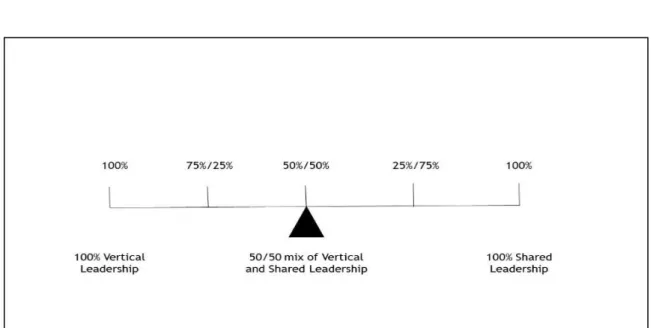
Factors that influence leadership style
- Influence of the type of project on leadership style
- The phase in the project life cycle
- Organisational project management maturity
- Organisational structure
The system consists of internal meetings of the project team, subcontractors and clients. Turner and Müller (2005) also mention that the stage in the project life cycle has an impact on leadership style.
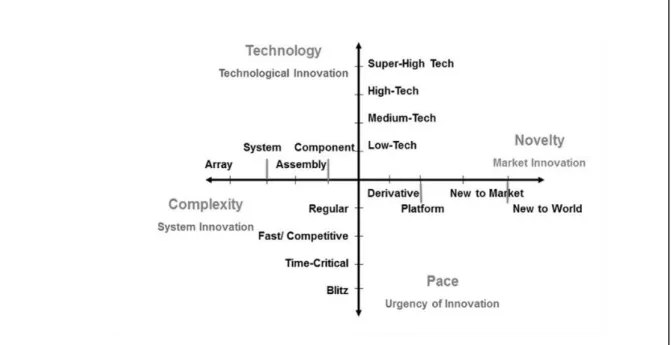
The level of trust and collaboration
- Level of trust and leadership style
- Degree of collaboration and leadership style
The level of trust is often an indicator of the amount of risk an individual is willing to accept. According to Hsu et al. 2017) shared leadership was found to perform better than vertical leadership in creating trust in a group.
Perceived project management performance/success
According to Bond-Barnard, Fletcher and Steyn (2018), collaboration can take place between individuals, organizations or between an organization and its shareholders. While Müller and Turner (2007) studied project manager success, this paper examines the factors that influence the right balance between shared and vertical leadership and its impact on project success and performance.
Conceptual model
Conclusion and discussion
Project Management Maturity and Project Management Success in the Engineering and Construction Industries in Southern Africa. The Contingency View on the Effect of Project Management Maturity on Perceived Performance, Schema Business School: Paper.
The effect of project types on leadership styles and project
Literature review
- Leadership
- Project types
- Balanced leadership
- Perceived project management success
- Conceptual model
Associations such as the Project Management Institute (PMI), the International Project Management Association (IPMA) and the United Kingdom. This dimension measures the difficulty of the product, tasks and project (Pretorius, et al., 2017).
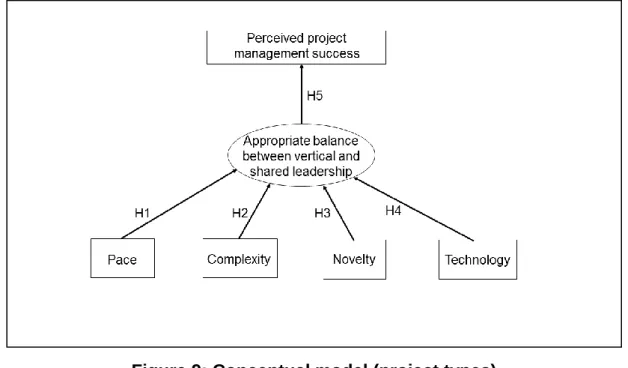
Research methodology
- The questionnaire
The part of the questionnaire that was used to test hypotheses 1 to 4, pairwise views for hypotheses 1 to 4, and descriptive statistics consisted of graphical rating scales. Vertical leadership was on one side of the scale (and represented 0% – the minimum value in Appendix 2) and shared leadership was on the other side (and represented 100% – the maximum value in Appendix 2).
Results and analysis
- Hypothesis testing
- Paired views
- Descriptive statistics
- Reliability and internal consistency
- Cross-tabulation
A total of 62% of respondents (Table 8) indicated that the balance would tip towards shared leadership as the pace of the project increases. A total of 59% of respondents indicated that the balance would tip toward shared leadership as the technological uncertainty of a project increases.
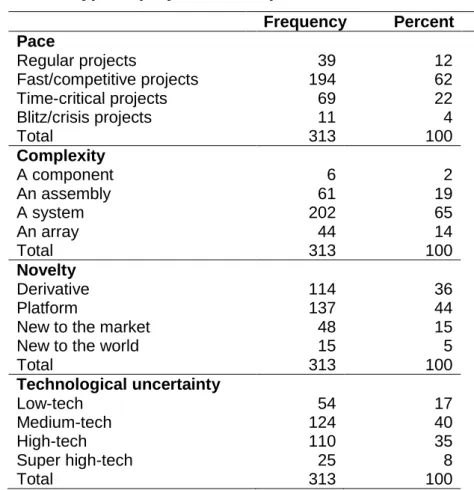
Discussion
In this section, it was investigated whether five industries were significant for the direction of the indicated balance. Respondents' typical role in a project, years of experience (except news projects), monetary value, and the industry they worked in had no influence on the choice of direction of management style for each project type.
Conclusion
Respondents were confident that the right balance of leadership would lead to perceived project management success. Assess and build on the underlying theory of project management in the face of projects going badly.
Vertical and shared leadership in project management
Literature review
- Leadership
- The project life cycle
- Project management success
- Conceptual model
It should not stand in isolation – most of the time a combination of vertical and shared leadership is used. The use of vertical and shared leadership must be adapted to the phase in the project life cycle (Crevani, Lindgren and Packendorff, 2007) as there is no fixed leadership style for a specific phase of a project (Patanakul et al., 2010; Turner and Müller, 2005) The above three phases are discussed next.
Research methodology
A pilot study was conducted before distributing the survey to the target group. The feedback from this study was used to improve the questionnaire in terms of clarity, accuracy and number of complete responses.

Results and analysis
- Hypothesis testing (H1 to H3)
- Hypothesis testing
- Paired views
- Reliability and internal consistency
- Cross-tabulation
An indicator was created to indicate whether the questions in each of the three hypothesis groups were indeed in the assumed direction (for example, the continuum between vertical and shared leadership). The p-value resulted in 0.079, meaning that H0 cannot be rejected - the mean does not deviate significantly from 50.

Discussion
This implies that the role in the project, years of experience, monetary value of the project and the main industry did not influence the choice of the direction of the balance of management style for any life cycle phase. Respondents' role in a project, experience, monetary value of the project and main industry had no significant influence on the choice of the direction of the management style for each project phase.
Conclusion
Project management for development in Africa: why projects fail and what can be done about it. An empirical study of the use of project management tools and techniques throughout the project lifecycle and their impact on project success.
Balancing leadership styles based on project types and life cycle
Literature review
- Leadership
- Project types
- Project life cycle phases
- Balanced leadership
- Project management success
- The Project Leadership Style (PLS) Model
H4: The higher the level of technology involved in a project, the more the balance is towards shared leadership. There is a continuum between vertical and shared leadership and there should be an appropriate balance where the leadership style is tailored based on the specific circumstances and needs of the project (Zander and Butler, 2010).
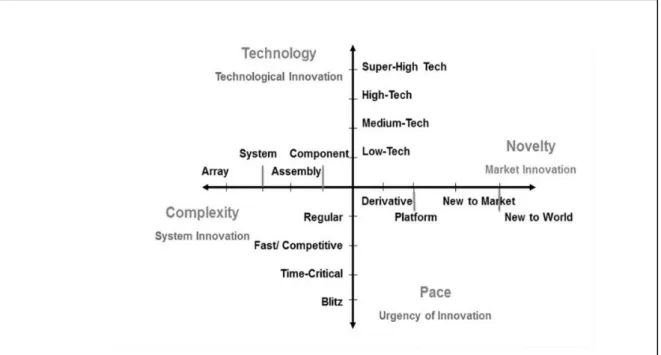
Research methodology
For Hypotheses 1 to 4 as well as Hypothesis 8, this test was conducted to assess whether there is a significant difference between the number of respondents who indicated the hypothesized direction (e.g. continuum between vertical and shared management) as opposed to those who stated contrasting views. An additional one-sample t-test was conducted for hypotheses 5 to 7: this test was conducted to examine whether the mean score (between 0 and 100, where 0 is vertical leadership and 100 is shared leadership) was above or below 50 as hypothesis.
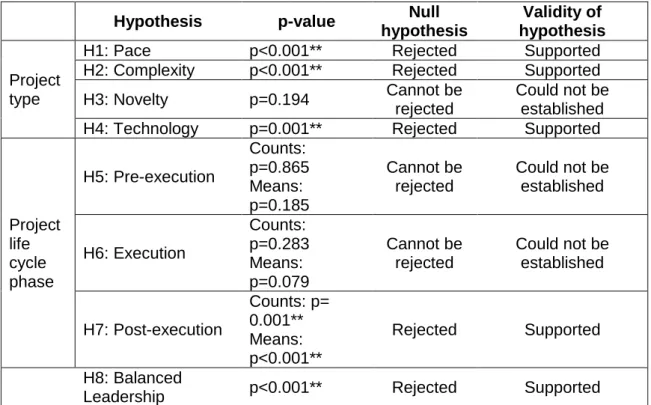
Results and analysis
- Demographic data
- Hypothesis testing
- Reliability and internal consistency
- Cross-tabulation
This indicates that the respondents were unsure about the influence of each project type and lifecycle stage on the right balance of leadership style. This indicates that years of experience have had an effect on the influence that novelty projects have on the direction of the leadership balance.
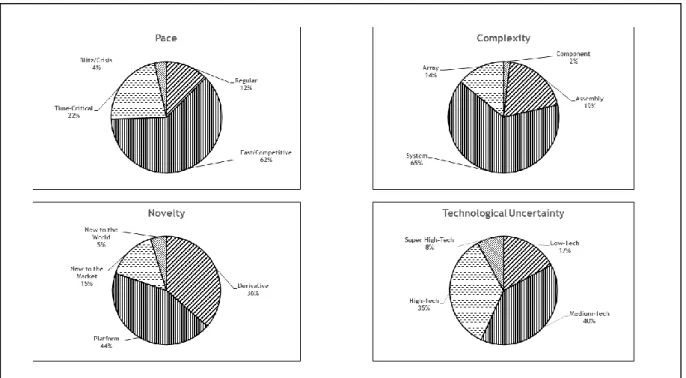
Discussion
Those involved in the execution phase of the project are often required to work with the client's team to get their approval on the project and to clarify the scope of the tender. The hypotheses are drawn from international studies and leadership styles in South Africa may differ from those hypothesized in the study.
Conclusion
This phenomenon occurs when team members in developing countries (such as South Africa) do not recognize Western approaches to project management. Project Management: Cost, Time, and Quality, Two Best Guesses, and Phenomenon, It's Time to Adopt Other Measures of Success.

Conclusions
- Introduction
- Theoretical framework
- Research methodology
- Main empirical findings and interpretations
- Demographic data
- Hypothesis testing
- Reliability and internal consistency
- Paired views
- Cross-tabulation
- Discussion
- The Project Leadership Style (PLS) Model
- The unique/original contribution of the study
- Implications to theory and practice
- Implications to theory
- Implications to practice
- Limitations and future research
The scientific relevance of this research is to establish a new model of leadership styles that takes into account the effect of project types and project lifecycle stages on leadership style (vertical leadership versus shared leadership), and how an appropriate balance between the two styles influences likelihood of project management success. H6: During the execution phase, which includes many of the monitoring and control aspects, the leadership style tends towards vertical leadership.
Guiding Diagram
Questionnaire
